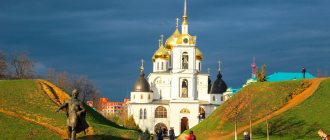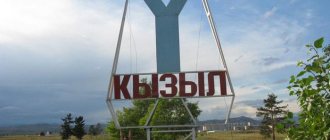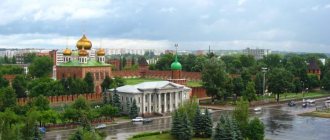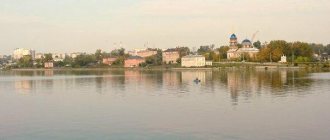In the town of Zaraysk near Moscow there is the smallest Kremlin, but it’s not the size, but the strong impression it makes, the magnificent museum, churches and interesting history: the spool is small, but expensive. And the landscapes around you cannot be described in words! The Zaraisky Kremlin is one of the best preserved in Russia. Built by Italian architects in the first third of the 16th century by order of Vasily III.
The Zaraisky Kremlin is part of the so-called Zasechnaya Line. This is a complex of fortress settlements built to protect the borders of the state from raids by nomads. It includes, for example, the Tula, Nizhny Novgorod and Serpukhov Kremlin (which has not survived to this day). In 2022 they are going to celebrate the 500th anniversary of the “Big Zasechnaya Trait”. The date is very arbitrary, since all these fortified cities were not built simultaneously and it took more than a decade to finalize such a powerful border. However, a date has been set (if you believe the Internet, it is “tied” to the anniversary of the Tula Kremlin) and by this date it is necessary to put in order all the surviving fortifications included in it.
Walls of the Zaraisk Kremlin
In particular, large-scale restoration work is being carried out on the Zaraisk Kremlin. The reconstruction is carried out in an original way: all the bricks are examined, the most poorly preserved ones are replaced, and a layer of dark red paint is applied on top. From a distance they look beautiful, but up close the feeling of brickwork, and with it the ancient fortress, disappears. By the way, from a distance it looks absolutely gorgeous. Beautiful views can be seen simply from the sides of the roads. They even install special “Zaraisk” signs and make “pockets” for stopping traffic so that you can take a photo, like a postcard. Only while the landscaping work is going on, the landscape looks terrible. In the foreground there are heaps of sand and gravel that spoil the footage. But this is temporary.
Panorama of Zaraysk
The entire territory of the Kremlin is a museum. It is better to walk along it with a guide. Moreover, the guides are knowledgeable and excellent at telling the history of the area.
History of the museum
The museum was founded in 1918, almost immediately after the October Revolution. It is named after the main object of the museum exhibition - the Zaraisk Kremlin. This is a defensive structure erected in the 16th century by order of Vasily II, Grand Duke of Moscow.
The main exhibition was placed in the building of the former government offices on the territory of the Kremlin. There is a unique archaeological collection there, it includes unique monuments of primitive art - bison figurines and “Paleolithic Venuses”, they were discovered on the territory of the Zaraysk Upper Paleolithic site1.
Tour of the walls
One of the most interesting and spectacular points in the program of visiting the Zaraisky Kremlin is the climb to its fortress wall. You can go up accompanied by a guide as part of a sightseeing tour of the fortress territory.
Visitors to the excursion have the opportunity to take a walk along the military course of the wall, as well as visit inside the Nikolskaya Tower, where a small historical exhibition with diagrams of old Russian fortresses is located. In the process, the guide tells a lot of interesting things about the history of the Zaraisk Kremlin and Zaraisk itself, about the features of fortification architecture, as well as about the tricks and techniques that allowed the defenders to hold back the enemy’s onslaught.
From the wall there is a magnificent view of the inner territory of the fortress and the attractions located on it: St. John the Baptist Cathedral, St. Nicholas Cathedral, the building of the Zaraisk Theological School and others.
But the views outside, towards the city, are not impressive. If you are interested in good views of the city, you should visit the local water tower, from the top of which the whole of Zaraysk is visible in full view.
Exposition
The museum is rich in exhibits reflecting the life of the noble class - these are portraits and objects of noble life of the second half of the 18th - early 20th centuries, brought here from the family nests of Zaraisky district. There are also portraits of local merchants, and even a collection of foreign art.
Part of the museum is the memorial house of A.S. Golubkina. Golubkina was an outstanding sculptor of her time. Another exhibition space is the Darovoye estate, where Dostoevsky visited as a child.
Another large exhibition presents a collection of Russian art from three centuries - XVIII, XIX and XX. First of all, this is a unique portrait painting. The main masterpiece of this collection is the ceremonial portrait of Countess M.A. Keller by Leon Bakst.
There is also the art of itinerants, such as V.M. Maksimov, I.I. Shishkin, V.K. Byalynitsky-Birul, S.V. Ivanov. There are also objects of decorative and applied art.
In the exhibition hall of the House of A.S. Golubkina opened the exhibition “A.S. Golubkina and Paris” to the 158th anniversary of the birth of the outstanding Russian sculptor.
As the title of the exhibition suggests, it is dedicated to a very significant period in the life and work of the Zaraysk artist. In total, Anna Semyonovna lived and worked in Paris for about three and a half years. For her, these were years of intensive artistic education and improvement of skills; It was here, in Paris, that her first success and real recognition of her work came.
At the opening of the exhibition in the home of the Zaraisk sculptor, admirers of her talent gathered: employees of the State Tretyakov Gallery, teachers of the Zaraisk Children's Art School, representatives of the education department of the city. Zaraysk, descendants of the Golubkin family, from whose private collections are a number of items presented in the museum. The official ceremony in the exhibition hall was preceded by a lithium in the Annunciation Church, and guests also laid flowers on the grave of A.S. Golubkina at the Zaraisk cemetery.
Opening the exhibition, director of the Zaraisky Kremlin State Museum K.V. Kondratyev emphasized that the museum continues the already established tradition of research exhibitions, each of which is dedicated to a specific stage in the biography or direction of A.S.’s creative activity. Golubkina. This project is “A.S. Golubkin and Paris” – quite fully, in his opinion, reflects, despite the chamber volume, the impressions of the Zaraisk sculptor about Paris, a kind of cradle of creativity of Russian artists of that period. The doctor of art history, who has spent almost her entire life studying the work of Anna Semyonovna, and a frequent guest of the Zaraisk House of A.S., also agrees with the head of the museum. Golubkina O.V. Kalugina. Her poetic statement - “Golubkina’s sculptures in this hall are shrouded in Paris” - caused applause from those present.
The head of the “House of A.S.” department introduced the guests to the thematic structure of the exhibition. Golubkina” N.A. Salomatina. The main sources for the information component of the exhibition were letters and memoirs of A.S.’s contemporaries. Golubkina from the archives of the Zaraisky Kremlin State Museum, a number of Russian museums and private collections. Sections of the exhibition consistently introduce the role of the family in the development of the artist’s personality, talk about her studies in Moscow and St. Petersburg, and reveal the reasons that prompted the artist to go to improve her skills in Europe.
A separate part illustrates Paris at the turn of the 19th – 20th centuries. – a place of attraction for Russian artists. The display cases feature photographs of Paris taken by M. Voloshin (his acquaintance with A.S. Golubkina took place there, in the capital of France), and sketches of views of the French capital by artist N.Ya. Simonovich-Efimova, a French fashion magazine of that time. Visitors will see here photographs of the works of Auguste Rodin, the Parisian mentor of A.S. Golubkina, as well as photographs of works from the Parisian period by Anna Semyonovna herself - the very ones with which she earned the sincere admiration of art-savvy Parisians, and for one of them - the figure “Old Age” - she was awarded a bronze medal of the French Academy of Letters and Arts (color image of this award also presented at the exhibition). Moreover, it is very interesting to compare – albeit not “live”, but from photographs – the sculptures of two great masters: “Old Age” by A.S. Golubkina and “La Belle Omière” by Auguste Rodin, for which the same Italian model served as a model.
A significant part of the exhibition space, naturally, is occupied by sculpture, which provides an opportunity to get acquainted with the creative fate of A.S. Golubkina after her return from Paris - a sculpture in which one can feel greater freedom of creativity, compared to the pre-Paris period. These are works made based on impressions from Zaraysk, as well as portraits of famous literary figures of that time. As Anna Semyonovna wrote in one of her letters to her relatives, “Paris has given me a lot” – this is exactly what this exhibition illustrates. Those who have already been to the House of A.S. Golubkina, I think a pleasant surprise awaits - a sculpture of A.S.’s nephew. Golubkina Mitya in marble from a private collection, which previously could only be seen in photographs.
The work of the exhibition “A.S. Golubkina and Paris” will last until July of this year.
Theater Museum in Zaraysk
Zaraysk near Moscow is the birthplace of the Bakhrushins. In Zaraysk, the ancestors of the founder of the Theater Museum named after. A.A. Bakhrushin lived for more than two centuries. In 1821, the founder of the dynasty, Alexey Fedorovich Bakhrushin, moved to live in Moscow, in Zamoskvoretsky Kozhevniki. The family walked the entire way, and simple household belongings fit on a single cart. Having saved money, Alexey Fedorovich bought a small tannery, then, one after another, plots of land around it. By 1834, Bakhrushin’s handicraft factory had turned into a factory, and in 1835 its owner was already on the lists of Moscow merchants.
The museum has been moving towards opening a branch since 2002, when the First Bakhrushin Charity Festival took place. The years of cooperation between the museum and the city were fruitful and successful. Trust in the museum became the foundation for the decision of the administration of Zaraysk and its deputy corps to transfer the building of the former city gymnasium in the city center to the museum to open a branch. The project was actively supported by the Ministry of Culture of the Russian Federation.
Currently, at the expense of its own funds, the museum has managed to carry out research and design work on a small scale. The design of the building has been completed and its measurements have been taken.
The main goals and objectives of the multifunctional museum and theater art are:
– preservation, development and popularization of the ideas of charity and patronage;
– acquaintance of the younger generation with the artistic values of the national cultural heritage;
– presentation and popularization of the State Central Theater Theater named after. A. A. Bakhrushin in regions and small towns as a unique cultural monument;
– effective assistance to small towns, their culture, spirituality; search for new directions that can influence the cultural climate of cities.
Museum employees, Deputy General Director of the State Central Theater Museum named after. A. A. Bakhrushin for scientific and educational activities Alexander Rubtsov and researcher Lidiya Postnikova developed the concept of the permanent exhibition of the branch. It consists of five sections.
The first is dedicated to Zaraysk in the context of history and modernity. Together with exhibits from the funds of the State Central Theater Museum named after. A. A. Bakhrushin, it will present materials from the Ryazan regional archive, family collections of descendants of the Bakhrushin family.
The second section will tell about the Bakhrushins - industrialists, philanthropists, philanthropists, collectors, about the magnificent and hospitable house of Alexei Alexandrovich and Vera Vasilyevna Bakhrushins, “Versailles on the Zatsep”, built by the outstanding architect Karl Karlovich Gippius.
The third section, “Central Russia—the preserved region of Russian literature,” will introduce visitors to the rich literary and theatrical heritage of Russian classics. Alexey Aleksandrovich Bakhrushin initially created his museum as a literary and theatrical museum, and Zaraysk and the entire central part of Russia are places directly associated with famous names and wonderful literary works, which found an excellent stage interpretation in the work of outstanding theater actors, directors and artists.
The fourth section received the enticing title “The World of Theatrical Backstage.” It includes interactive blocks that maximally involve visitors in the process “behind the scenes”: “Artistic dressing room”, “Costume room”, “Stage machinery”. Noise machines." The history of the Bakhrushinsky Charity Festival in Zaraysk will be presented in the fifth section of the permanent exhibition.
Temporary exhibitions, outreach and educational projects, programs aimed at supporting creative associations in Zaraysk - all this is included in the scope of the aspirations and plans of the Theater Museum in Zaraysk. Special attention in the concept is paid to infrastructure: in addition to the mandatory landscaped territory, a comfortable visitor center, Wi-Fi zones, a cafe and a souvenir shop in a modern museum space, it is planned to open an art hotel with rooms decorated in different artistic styles related to the themes of literature and theater .
The “Theater Museum in Zaraysk” is also intended to increase the tourist attractiveness of Zaraysk, which is included in the list of the main cultural tourism sites in the Moscow region.
Concept of the branch “Theater Museum in Zaraysk”
Contacts:
Branch curator, deputy Head of the Regional Development Department - Alexander Rubtsov.
Tel.: +7 /499/ 484 77 77 ext. 1107
Senior administrator – Viktor Nasekin
Tel.: +7 /968 /823 08 23; +7 /499/ 484 77 77; 8/800/7777484
Email: [email protected]
Go to the poster
How to get there and excursions
You can also visit the Kremlin and the museum on your own. When a group of 5 people gathers, excursions are conducted: - around the Kremlin on weekdays at 13-00, on weekends and holidays at 12-00 and 14-00 - around the museum on weekends and holidays at 13-30 and 15-30 - at to all objects on Wednesday, Thursday, Friday at 12-00, on weekends at 13-00 The Kremlin is closed on Monday, Tuesday and the last Friday of the month. You can get there on your own from the Kotelniki metro station by bus No. 330, by car along the Ryazanskoye or Kashirskoye highway. Address: Zaraysk, st. Museum, Kremlin, website https://museumzaraysk.ru/
History of the Zaraisk Kremlin
The Kremlin in the small village of Novogorodok-on-Osetra was built by order of Vasily III in 1531. Two years later, the fortification was subjected to the first attack by the Crimean Tatars, but successfully survived. Over the next half century, the fortress was besieged by the troops of the Crimean Khan five times, but they were never able to take it. From the 16th to the 19th centuries, Novogorodok-on-Osetra changed its name several times: Zarazsk, Nikola Zarazskaya-on-Osetra, Zoraisk, Zaraisk. The modern toponym was finally established only in the 19th century. The fortress itself began to be called the Zaraisk Kremlin.
The fortification walls are made of brick. During construction, a space was left between them, which was filled with small river stones and mortar: this design best withstood the impacts of rams, and later - cannonballs. At the corners of the fortress there are four twelve-sided blind towers - they do not have gates, they were intended only for the defense of the Kremlin. Three quadrangular shaped carriage towers were built in the northern, southern and western walls. The gate on the east side appeared only in 1789. By this time, the Kremlin had lost its defensive significance, and the small town of Zaraysk had turned into a major center of merchant trade and then industry.
Museum expositions
In the museum you can see interesting collections of paintings, sculptures and graphics, decorative and applied arts, represented by samples of furniture made by Russian and Western European craftsmen. Exhibitions presented by porcelain, glass and bronze works of art enjoy well-deserved attention among museum visitors. Among the exhibitions dedicated to the history and ethnography of the region, you can see various examples of the creativity of folk craftswomen: embroidery, weaving, items of peasant everyday and festive clothing.
In addition to the exhibitions located in the building of the Trinity Church, museum visitors have the opportunity to book a tour of the territory of the Zaraisky Kremlin, during which they can learn the history of its creation, military purpose and various features associated with the construction of the Kremlin.










